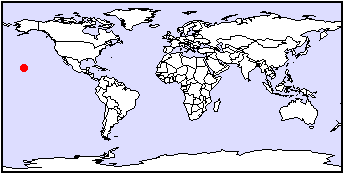 |
 |
Town/City: |
Island of Molokai |
State/Province: |
Hawaii |
Country: |
U.S.A. |
Latitude/Longitude: |
20N 156W |
Information supplied byKevin Lok97lokkwk@fissure.scar.utoronto.ca(416)296-9118 Dated Mon Oct 19 09:51:32 1998 |
|
 |
 |
Town/City: |
Island of Molokai |
State/Province: |
Hawaii |
Country: |
U.S.A. |
Latitude/Longitude: |
20N 156W |
Information supplied byKevin Lok97lokkwk@fissure.scar.utoronto.ca(416)296-9118 Dated Mon Oct 19 09:51:32 1998 |
|
The Island of Molokai is the fifth largest of the Hawaiian Island, with an area of 260 square miles. Molokai has two geographic areas: the East Molokai dome and the West Molokai dome. Hoolehua Plain, contains about 28,000 acres of land covered with deep soil is situated between East and West Molokai dome. The island has a population of less than 10,000. The chief industry is the production of pineapple and livestock other than tourism.
The climate of Molokai is semitropical. It lies in the belt of northeasterly trade winds, which blow almost constantly throughout most of the year. The average mean temperature is 72.5 F and the annual mean precipitation is 20 inches in the West Molokai and 35 inches in the East Molokai. The rainfall is highest on the west and windward slope of the East Molokai, decreasing rapidly toward the leeward coast.
Nearly the entire island is underlain, close to sealevel, by groundwater of the basal zone of saturation. Beneath West Molokai, the Hoolehua Plain and the southern coastal area of East Molokai, fresh basal water is obtainable but is not economically feasible. Small amounts of fresh water are perched at high levels in East Molokai by thin poorly permeable ash beds. Fresh water is confined at high levels in permeable compartments between poorly permeable dikes in the rift zones of East Molokai, and can be developed by tunnels. The perched groundwater from Kamiloloa aquifer system provides the only source of drinking water on the island.
There is plenty of groundwater on the island of Molokai, but the Kamiloloa aquifer system provides the only source of drinking water on the island. It is also widely used for agricultural and urban uses such as parks and hotels for tourists. It is owned and operated by the Hawaii Home Commission. Shallow dug wells are another source of water for agricultural use, especially along parts of the southern coast.
Nearly all the basal water of West Molokai is brackish. Likewise, most basal water produced from many of the shallow wells east of Kawela Gulch is brackish because of the nearness of the wells to the ocean. Also, wells dug deeply below the water table yield water that is more brackish. Much of the surface and groundwater on the East Molokai is weakly acidic, this results in a high rate of corrosion of steel pipes. The development of the island has been greatly retarded by the lack of water in the inhabited areas. Large areas of rich soil exist in Hoolehua Plain but lack sufficient irrigation for most agricultural uses.
Salinity and acidity of the basal water on the island; slow recharge rate due to low precipitation; lack of sufficient irrigation to Hoolehua.
There are proposals to bring the abundant water of large windward valleys of East Molokai to the dry leeward slope and the Hoolehua Plain. The Molokai project would greatly change the economy of the island.
Sterns, Macdonal. Geology and groundwater
resources of the Island of Molokai, Hawaii. Hawaii,
U.S. 1947.
Sterns, Macdonald. Groundwater resources of the
Island of Niihau, Hawaii. Hawaii, U.S. 1947.
http://www.pixi.com/~nhac/molokai/molokai.html
http://www.hawaii.gov/
U.S. Geological Survey, 333 Federal Bldg., Honolulu, Hawaii